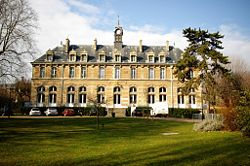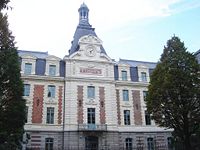Secondary education in France
In France, secondary education is in two stages:
- the collèges compremise the first four years of secondary education from the ages of 11 to 15;
- the lycées provide a three-year course of further secondary education for children between the ages of 15 and 18. Pupils are prepared for the baccalauréat degree, which upon creation can lead to higher education studies or directly to professional life.
Overview
Education in France falls under the jurisdiction of the French Ministry of Education. Compulsory education starts at the age of 6, when students enter primary school, and ends at the age of 16, usually after completion of the collèges. A majority of students go on to attend the lycées, but it is based upon achievement and successful completion of the collège curriculum.[1]
In contrast with most other education systems, the French use a decreasing numerical system in naming the various school years. Pupils begin their secondary education in the sixième (form 6), and transfer to a lycée in the seconde (form 2), while the final year is the terminale.
French parents are not free to choose the public school that their children will attend; unless said children have special pedagogical needs, they will attend the school allocated to them by the carte scolaire (school map). Reasons for attending a different public school, other than the local assigned one, include studying a unique elective (e.g. a rare foreign language) unavailable in the assigned school.
Collège
| Collège | ||
| Age | Name | Abbreviation |
|---|---|---|
| 11-12 | Sixième | 6e |
| 12-13 | Cinquième | 5e |
| 13-14 | Quatrième | 4e |
| 14-15 | Troisième | 3e |
The collège is the first level of secondary education in the French educational system. A pupil attending collège is called collégien (boy) or collégienne (girl). Men and women teachers at the collège- and lycée-level are called professeur (no official feminine professional form exists in France).
Entry in sixième occurs directly after the last year of primary school, called cours moyen deuxième année (CM2). There is no entrance examination into collège, yet administrators have established a comprehensive academic examination of students starting sixième. The purpose of the examination is evaluating the pupil's level on being graduated from primary school.[2]
Curriculum
Along with three-to-four weekly hours of physical education, a typical school week consists of some twenty-six (26) hours of schooling. French language and literature occupy the most time, 4-5 hours per week, followed by mathematics, 4 hours per week; other subjects occupy some 1.0-3.5 hours per week.
The curriculum is devised by the French Ministry of National Education and applies to all collèges in France and also for AEFE-dependent institutions. Académies and individual schools have little margin for curriculum customization. Teachers compose syllabi per precise government educational regulations, and choose textbooks accordingly; every major French publishing house has a textbook branch.
Organization
Each subject usually is taught by a different professeur (teacher); most professeurs teach different age groups. Collège students sit with the same group of students throughout the school year, and in every subject (except optional courses, e.g. foreign languages, students from several groups mix). Therefore, in each grade, pupils are divided into as many classes as necessary, because there exists the strong pedagogical belief in mixed-ability classes.
Class size varies from school to school, but usually ranges between 20-35 pupils. Each classe has a professeur principal (principal professor) who is the link among the faculty, the administration, and the pupils. Early in the school year, the students elect two délégués (delegates) and two suppléants (substitutes) from their own classes. They represent the pupils in the class council, acting as links between the students and the principal professor (head teacher).
Professeurs, administrators, and delegates of each grade meet three times a year in conseil de classe (class council). In those meetings are discussed the individual level of each student, and of the class, and matters of logistics and discipline inherent to the group of pupils.[3] It is during those meetings that the conseil de classe bestows either honors or warnings on the bulletin de note (report card).
Ultimately, the role of the collège is to prepare students for the advanced subjects of the lycée. At the end of troisième, students sit for le diplôme national du Brevet, an end-of-collège examaniation; The brevet is not required for entrance to the lycée, nor does passing it guarantee that a student will progress to the higher-level school.
During the last conseil de classe of the year, held in June, the professeurs and administrators decide whether or not a student can progress to the next grade. In deciding, they evaluate the student's skills, participation, and behavior. Three outcomes are possible:
- the student progresses to the next grade;
- his or her redoublement (redoubling or repeating) can be required;
- he or she can, in specific cases, be offered to skip over a grade and be promoted two grades.[4]
A student asked to repeat a grade can appeal the decision for review, yet the decision of the appeals council is final.
Lycée
| Lycée | ||
| Age | Name | Abbreviation |
|---|---|---|
| 15-16 | Seconde | 2de |
| 16-17 | Première | 1e |
| 17-18 | Terminale | Term |
The lycée is the second, and last, stage of secondary education in the French educational system. At the end of the final year of schooling, most students take the baccalauréat, the end-of-lycée diploma students sit for in order to enter university, a classe préparatoire, or professional life. There are three different types of baccalauréat examinations for the three different paths a student has chosen to study while attending the lycée:
- baccalauréat général - Prepares students to enter higher educational institutions.
- baccalauréat technologique- Short-term studies in differing technology fields.
- baccalauréat professionel - Vocational qualification leading directly to a particular career.[5]
Each of these different baccalauréat are prepared for by specific streams of study, known as séries, which are chosen in the seconde year of school. The decision of which type of education to enter is based upon the wishes of the student, his/her family and a review by the admissions council of the student's previous work.[6]
Baccalauréat Général
Most students sit for the baccalauréat général which is divided into 3 streams of study. The série scientifique (S) is concerned with the natural sciences, physics or mathematics (a lot of streams exist, one of which is called série scientifique sciences de l'ingénieur (SSI), a série scientifique baccalauréat with two more specializations, génie électrique and génie mécanique. There is also the Bac STI, Sciences & industrial technologies. There also exists the option génie mécanique & the options electrotechnique), the série économique et sociale (ES) with social sciences, and the série littéraire (L) focuses on French and foreign languages and philosophy. However, these séries are not exactly specializations and every bac-possessor has the right to integrate any public university in his catchment area if this applies to the subject he wishes to apply for. Students having followed the L series do not have enough scientific knowledge from high school alone to succeed in science university courses, therefore some combinations of baccalauréats and university courses are very rare. In all streams, students have philosophy courses in terminale, while French language classes end in the première, excepting the série L, where they become French literature classes.[7]
| Streams | S scientifique (various hard sciences) |
ES économique et social (economics and social sciences) |
L littéraire (humanities) |
| Description | The sciences stream requires high-level mathematics (very heavily weighed), physics, and chemistry. | The série ES is balanced between literary and scientific courses; students must take an economics and social sciences exams. | The série L heavily weighs French language, history and geography and foreign languages; also including a literature section. Students must present examinations in one-to-three modern languages, and also have the option of presenting examinations for either Latin or ancient Greek or for both. |
Baccalauréat Technologique
The are eight streams that result in the taking of the baccalauréat technologique:
- sciences et technologies de la gestion (Management Sciences and Technologies, STG)
- sciences et technologies industrielles (Industrial Science and Technologies, STI)
- sciences et technologies de laboratoire (Laboratory Science and Technologies, STL)
- sciences médico-sociales (Health and Social Sciences, SMS)
- sciences et technologies du produit agroalimentaire (Food Science and Technologies, STPA)
- sciences et technologies de l'agronomie et de l'environnement (Agronomy and Environment Science and Technologies, STAE)
- techniques de la musique et de la danse (Music and Dance Techniques, TMD)
- hôtellerie[8]
The STPA and STAE stream are only available in lycées agricoles, specialty schools for agricultural sciences.
Baccalauréat Professionnel
The Lycée Professionnel leads to several, different vocational diplomas in all fields of study. The enrolled students are not planning on getting a higher education, as the schooling is vocational training as craftspeople and through internships in companies. It is a good track of schooling for students more interested in a hands-on educational approach than in academic schooling and learning.
The first diploma, the CAP, is prepared for during 2 years; usually preparing the student for a specific occupation: carpenter, childcare provider, tailor, and so on. It is the easiest obtainable diploma, hence, the academically weakest students often follow this schooling track.
The second diploma, the BEP, is prepared for during 3 years, after the collège. It leads to a professional qualification in a specific field, such as restaurant industry, metallurgy, et cetera. It is more difficult diploma to earn than a CAP diploma; some students who have earned a CAP continue to a BEP.
The final diploma is the Baccalauréat Professionnel, the BP, it is the highest professional qualification available. It can be prepared for during 3 years after the college, but most students first earn a BEP and then continue to a Bac Professionnel.
Notes
- ↑ France. (2008). In Encyclopædia Britannica. Retrieved May 24, 2008, from Encyclopædia Britannica Online: http://www.britannica.com/eb/article-41173
- ↑ Louis, Francois. Secondary Education in France: A Decade of Change. (Organization for Economic Cooperation & Development 1995) ISBN 9264145486
- ↑ H. D. Lewis (1985). The French Education System. Routledge, 58. ISBN 0709916833.
- ↑ (2007) Discover France "Education in France: Part 1 Retrieved May 24, 2008
- ↑ Louis, Francois. Secondary Education in France: A Decade of Change. (Organization for Economic Cooperation & Development 1995) ISBN 9264145486
- ↑ (2006) The France National Ministry of Education "Regristration" Retrieved May 30, 2008
- ↑ (2001) European Education Directory "France" Retrieved May 26, 2008
- ↑ (2006) The France National Ministry of Education "Bachelor Technology" Retrieved May 26, 2008
External links
All links Retrieved December 10, 2007.
- French Ministry of Education (in French)
- Bulletin Officiel (in French)
- Centre national de documentation pédagogique website (in French)
Credits
New World Encyclopedia writers and editors rewrote and completed the Wikipedia article in accordance with New World Encyclopedia standards. This article abides by terms of the Creative Commons CC-by-sa 3.0 License (CC-by-sa), which may be used and disseminated with proper attribution. Credit is due under the terms of this license that can reference both the New World Encyclopedia contributors and the selfless volunteer contributors of the Wikimedia Foundation. To cite this article click here for a list of acceptable citing formats.The history of earlier contributions by wikipedians is accessible to researchers here:
The history of this article since it was imported to New World Encyclopedia:
Note: Some restrictions may apply to use of individual images which are separately licensed.

